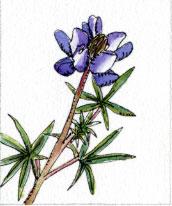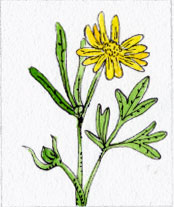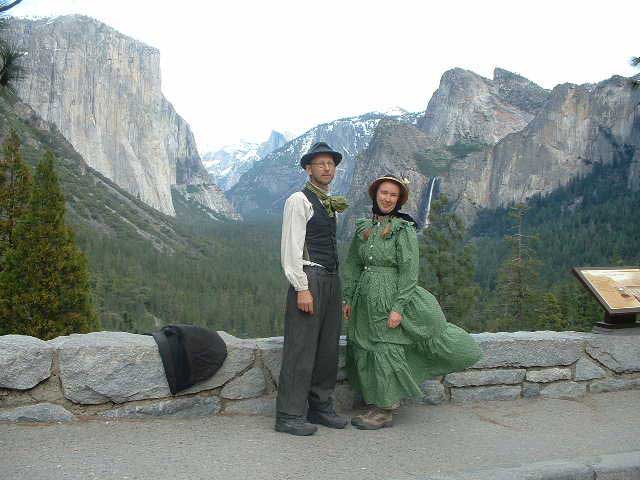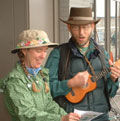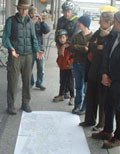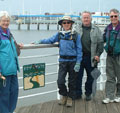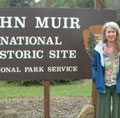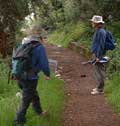Day one, 4/2/06
So here is how it all started:
We went to the John Muir Conference at UOP in Stockton. It was great.about 80 Muir scholars and a bunch others there to listen. We learned so much about Muir we hadn't really thought about before:
John Muir is the man on the California quarter, and he is there for a good reason: he is a hero in the Homeric sense of the word. He was a feel-no-pain, extreme, hardcore mountaineer, an early explorer of Yosemite, and a deeply religious man who ecstatically saw God in all nature. He was father of the Conservation movement in the USA, and is an archetypal role model for the Californian outdoors-person.
The conference ended Saturday and we spent the night in San Francisco, just like Muir would have done, except we stayed with our backpacking buddy Dave Worton, and spent the night talking about the Sierra and next summer's trip.
So we talked late, and then, almost not remembering the change to daylight savings (spring forward) we were running late and so we almost missed our send off party at the ferry terminal. There were about 30 people there in the drizzle waiting for us, and about a quarter of them came from reading Carl Hall's article in the Chronicle that morning. We gave a talk and I sang a newly composed John Muir folk song. What a great celebration. What a send off. What a romantic way to leave on a trip, waving to our friends as the ferry pulled away from the dock. We understand why Muir was always writing about missing his friends and family.
Four people even took the ferry with us to Oakland, (including Howard Cooley, one of our Muir scholars who we had only met through email), and the two accompanied us on the first day's walk. We were even met at the Oakland ferry terminal by Ione, a lady who read the article. She showed us where the trail was and walked with us for half an hour or so. The trail was not easy to follow; we would have just walked straight down the street if she had not shown us to walk out to the docksides and along the promenades that have been built to create this section of the Bay Trail.
It was grey, but did not rain and we walked along the Bay Trail, then up to Lake Merritt and went to the Oakland Public Library to see the collection of historical pictures on the walls. We ended the day by taking Bart to Mat and Maureen's house where we spent the night.
Santa Cruz, March 20
The project began with only the thought to walk across California to Yosemite, as John Muir had done. To find the route, we contacted various hikers we knew and then John Muir scholars, and were surprised to find that no one had attempted to retrace this route before. What began as a simple idea, quickly grew in scope and scale.
Our first step was research in historical archives like the Holt-Atherton Library at University of the Pacific, to discover the details of John Muir's trip. We found that though Muir kept diaries all his life they were missing for the time of this trip, and that the most contemporary account was an 1872 magazine article entitled "Rambles of a Botanist". We read his letters to get a sense of who he was and what he might have done. We used historic maps to locate roads that existed in 1868 and to determine his most likely route. We read many diary accounts and travel books from the 1860-1870s, to get a sense of what traveling in California was like then. 1868 was the year before the Golden Spike was driven, and the California Muir arrived in was quite different from what it was a few years later, after the transcontinental railroad was completed.
We decided that for the most part Muir would have walked on roads, rather than traveling cross-country. The roads in 1868 were dirt and often muddy or dusty, but as Muir's trip was in spring the roads would have been at their finest. A study of 1868 maps shows that he would not have had a choice of through roads. There was only one road from Oakland, the Oakland-San Jose Road (which is now sandwiched between the 880 and the 680, just as there was only one road leaving San Jose, the San Jose-Monterey Road that is now the 101.
John Muir left San Francisco on April 1, 1868. We decided to leave close to his date so that we would be walking in the same season, to experience the same flowers. We will begin our walk on April 2, 2006, after attending the John Muir in Global Perspective Conference at the University of the Pacific.
We are still trying to determine the logistics, like, how far will we walk a day, and where will we sleep? Will we want to camp out and carry a backpack?
Will we get permission to walk through private land or will we only travel on public lands that can also be used by others? We have decided that we will walk a route that parallels Muir's, using walkways, bike paths and open spaces, as much as possible, so that we will be walking through a California that is similar to the one Muir experienced. We have been very excited to find that least two thirds of the our trip will easily pass on public walkways or public lands. For example, the San Francisco Bay trail goes from Oakland to Alviso, the Guadalupe River Trail essentially from Alviso to San Jose, and the Coyote Creek Parkway trail from San Jose to Morgan Hill. From Morgan Hill we can enter Henry Coe State Park to get to Pacheco Pass. We are still planning the route, talking with rangers in the various parks, and it is very exciting when we find new possibilities.
